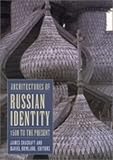Architectures of Russian Identity, 1500 to the Present / ed. by James Cracraft, Daniel B. Rowland.
Material type: TextPublisher: Ithaca, NY : Cornell University Press, [2018]Copyright date: ©2003Description: 1 online resource (264 p.) : 79 halftonesContent type:
TextPublisher: Ithaca, NY : Cornell University Press, [2018]Copyright date: ©2003Description: 1 online resource (264 p.) : 79 halftonesContent type: - 9781501723582
- 720/.947 21
- online - DeGruyter
| Item type | Current library | Call number | URL | Status | Notes | Barcode | |
|---|---|---|---|---|---|---|---|
 eBook
eBook
|
Biblioteca "Angelicum" Pont. Univ. S.Tommaso d'Aquino Nuvola online | online - DeGruyter (Browse shelf(Opens below)) | Online access | Not for loan (Accesso limitato) | Accesso per gli utenti autorizzati / Access for authorized users | (dgr)9781501723582 |
Frontmatter -- Contents -- Preface -- Introduction -- 1. Peter the Great and the Problem of Periodization -- PART I. MUSCOVITE RUSSIA -- 2. The Throne of Monomakh -- 3. Architecture and Dynasty -- PART II. IMPERIAL RUSSIA -- 4. Catherine the Great's Field of Dreams -- 5. Russian Estate Architecture and Noble Identity -- 6. The Picturesque and the Holy -- 7. Constructing the Russian Other -- 8. The "Russian Style" in Church Architecture as Imperial Symbol after 1881 -- 9. Civilization in the City -- PART III. SOVIET RUSSIA -- 10. Stalinist Modern -- 11. The Greening of Utopia -- 12. The Rise and Fall of Stalinist Architecture -- PART IV. POST-SOVIET RUSSIA -- 13. Conflict over Designing a Monument to Stalin's Victims -- 14. Architecture, Urban Space, and Post-Soviet Russian Identity -- Notes -- Contributors -- Index
restricted access online access with authorization star
http://purl.org/coar/access_right/c_16ec
From the royal pew of Ivan the Terrible, to Catherine the Great's use of landscape, to the struggles between the Orthodox Church and preservationists in post-Soviet Yaroslavl—across five centuries of Russian history, Russian leaders have used architecture to project unity, identity, and power. Church architecture has inspired national cohesion and justified political control while representing the claims of religion in brick, wood, and stone. The architectural vocabulary of the Soviet state celebrated industrialization, mechanization, and communal life. Buildings and landscapes have expressed utopian urges as well as lofty spiritual goals. Country houses and memorials have encoded their own messages. In Architectures of Russian Identity, James Cracraft and Daniel Rowland gather a group of authors from a wide variety of backgrounds—including history and architectural history, linguistics, literary studies, geography, and political science—to survey the political and symbolic meanings of many different kinds of structures. Fourteen heavily illustrated chapters demonstrate the remarkable fertility of the theme of architecture, broadly defined, for a range of fields dealing with Russia and its surrounding territories. The authors engage key terms in contemporary historiography—identity, nationality, visual culture—and assess the applications of each in Russian contexts.
Mode of access: Internet via World Wide Web.
In English.
Description based on online resource; title from PDF title page (publisher's Web site, viewed 26. Apr 2024)


